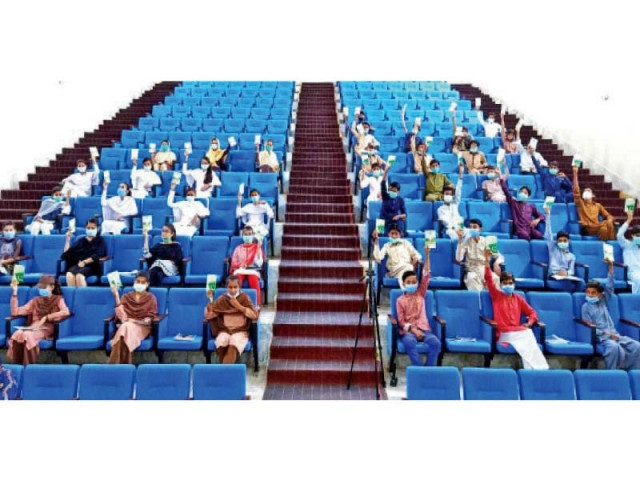Mentoring youth: banking and economy
Youth is indicator of how developed a country is, how fast or slow economy grows

The following was composed as an address to the 17th Youth Parliament, organised by Pakistan Institute of Legislative Development and Transparency, on August 28, 2022.
I have been posed with a few questions by the organisers of the event with respect to the topic of my talk. I would like to begin by shedding light on my decision making process while bringing about impactful changes at the Bank of Punjab (BOP), making it more consistent with customers’ expectations of a modern, digitised, tech-savvy, and customer-centric financial institution.
Under my leadership, it remains a strategic priority to position the bank as having the risk appetite of a public sector organisation, coupled with service excellence of a private sector entity, without compromising on governing control regime with robust environment of compliance, risk and audit.
Another strategic priority was to attract and retain the top-most talent from the market – subject matter specialists and experts – and this was tempered by instilling a culture of meritocracy across the organisation, wherein high performance is incentivised and career progression is purely merit-based.
We had marked 2021 as the year of “Our People” and 2022 as the year of “Empathy”. What this entails on the organisational level is the assertion that the bank puts the welfare of its people and their families as one of its foremost priorities. Additionally, another area of focus that was previously overlooked is leveraging social media for better internal and external communication. Now, BOP is closer to being accepted as a household brand name, and its competitive products and services are becoming known to everyone.
Significant focus was also exerted on Corporate Social Responsibility. I am a firm believer that business growth must go hand in hand with contribution to society, particularly, in terms of giving back to the less fortunate members of our community, enhancing financial inclusion, and improving lives through literacy and empowerment.
Insofar as the structural changes that I would like to see in the banking sector over time, there are three core aspects that I would like to address in this context. Firstly, the share of private sector credit shall increase with reduced reliance on financing to the dominant borrower (ie the government of Pakistan).
Compared to its peer economies, Pakistan’s financial sector remains underdeveloped, principally in financing the private sector. This can be demonstrated by considering credit or loans to the private sector as a percentage of GDP. While credit to the private sector in Pakistan has increased in absolute terms, it has declined as a percentage of GDP (17% in 2020, down from 29% in 2008).
The reasons for this are multifaceted; the biggest impediment being government borrowing. Credit from the banking sector to the government has risen by more than 400% in the last decade.
This rapid broadening of financing of the government has resulted in 66.8% of all credit extended by the banking industry being directed towards the government (as of December 2021). Another reason, on the demand side, remains Pakistan’s large informal sector.
Second one is: the constitution of the banking industry. Currently, it’s totally lopsided and concentration of assets and liabilities rests with a handful of large banks, who literally drive the agenda of the entire sector.
This warrants a paradigm shift in the present constitution of the banking sector whereby a board based funding could be diverted to more desired and unconventional sectors, like agriculture, infrastructure, etc.
Third and the last focus item is that banking in Pakistan, in a very basic sense, is the game of access to cheaper deposits, whoever has that is the winner. Therefore, it’s critical that the institutions having larger deposit holdings, which are merely driven by the size of their network, shall be able to divert these deposits to more productive, specialised areas.
In this respect, an attempt was made by the previous governments in the form of programmes, like e-Kissan in Punjab and Kamyab Pakistan in Islamabad, whereby these funds were made available to those sectors which were precluded from financing in the past. A quick rundown of some of the lessons I have learned through my experience in the banking and financial sector would include; a strong, uncompromising ethical framework and moral code, emphasis on the importance of long-term interpersonal relationship building, prioritising a people-first approach insofar as empathy and care for individuals is concerned, and an unflinching and clear focus on strategic goals, while keeping in view the tactical objectives.
Neglecting morals in business may net you the odd, short-term gains, but true business practitioners do not trade the long-term for the short. The presence of an ethical framework in business or otherwise is crucial and getting more important as humans are evolving and geographical boundaries are blurring. The walls and layers are tearing down. The world is shrinking and inhabitants are becoming closer.
The recent pandemic globally and, on the local level, the ongoing catastrophe owing to unprecedented flooding, has reinforced this thought. Moving on to my assessment regarding the future of the Pakistani economy, in brief, my vision about our economy going forward is that we shall be self-reliant, and self-sufficient.
Self-reliance – defined as the ability of a country to plan, finance, and implement solutions to solve its own development challenges – which are driven by two factors: commitment and capacity. Commitment captures, how well a country’s laws, policies, actions and informal governance mechanisms — such as cultures and norms — support progress toward self-reliance.
Capacity measures how far the country has come in its ability to manage its own development journey across the dimensions of political, social, and economic development, including the ability to work across these sectors.
The economy must be fully inclusive with benefits to all. Bottom-up or trickle-down approach, irrespective, at the end of the day, inclusivity is the key. Some of the main factors that act as barriers to financial inclusion in Pakistan include high rates of economic informality in the country.
Another reason is the high prevalence of cash-based transactions, and the general apprehension observed among the public with regards to documentation and formalisation.
And finally, one of the foremost reasons of low rates of financial inclusion in the country is the low rates of women participation in the economy. At the end of the day, all our actions shall be solely and squarely to the benefit of our people and people alone. Nothing more, nothing less…
Economic growth, in isolation, does not tell the whole story, of course. There is also a need to look at the Human Development Index score, which measures improvements in literacy, health and income. Data from the most recent Human Development Report shows that with a Human Resource Index (HDI) score of 0.557, Pakistan ranks 154th out of 189 countries — Bangladesh and India come in at 133 and 131, respectively.
This report further shows that Pakistan’s HDI score is 13% below the average HDI in South Asia and thus Pakistan ranks at the bottom of the entire region. Raising living standards in Pakistan is going to require a democratic turn. Data visualisation provided by the Human Development Report reveals additional information. Pakistan saw improvements but there’s still a long way to go.
The main problem in Pakistan remains that economic growth has been confined to non-productive sectors like real estate, etc, where elites have been able to draw tremendous rents.
Elites capture resources in other countries too, but in Pakistan’s case they have not reinvested in broad-based economic production, which could have helped boost exports and create solid, middle-class, jobs. The result is that businesses become richer and wealthier at the expense of the exchequer.
Moving on to the role played by Pakistan’s youth in economic development, a nation’s youth is often referred to as its heartbeat.
Youth are crucial for sustaining and enhancing the vitality of an economy. Pakistan’s young population is ranked at the fifth highest in the world.
Around 63% of our population is between the ages of 15 and 33. Although generally regarded as a demographic dividend, such a large youthful population, paired with suboptimal youth engagement in various domains indicates ineffectiveness of the public and private sector policies. The key is to empower the youth and harness their potential for human development. The three drivers for change to this end include the provision of quality education, gainful employment, and meaningful engagement.
UN reports have found that more than 9 million children are excluded from primary schooling in Pakistan. Current annual net enrollment rate stands at under 1%.
To reach the goal of universal primary education for all school-age children by 2030, the annual net enrollment rate has to increase to 3.8%.
The provision of education also affects the next dimension of change; ie, employment. The UNDP estimates that 4 million youth enter the working age population every year. At this rate, 0.9 million new jobs are required every year over the next five years.
This can also be spurred by incentivising entrepreneurship among the youth; this bottom-up approach to job creation has been known to generate promising results with quick turnarounds, and also serves to allow the youth to have productive, constructive outlets to vent their creative energies.
In general, therefore, for a country to promote economic growth, it must increase the level of capital generation. However, the transition from educational training to participating in capital generation by working is still not seamless and easy.
This is part of the reason why Pakistan has high levels of youth unemployment, since Pakistan, like other developing countries, is lacking in the two crucial domains of education and job creation.
Low education standards render many graduates unfit for the labour market. Industry-academia linkages are one pertinent way of addressing this gap.
The linkage of academia and industry has a strategic role in developing critical skills required by industry (both production and service sector), generation, acquisition, and adoption of knowledge, and in promoting entrepreneurship (start-ups and spin-offs).
The silverlining, however, is that the governments are very well aware of it and the present Prime Minister’s Youth Business Programme is working in this direction in a focused fashion. Any country with a vision to achieve sustainable economic growth requires the maximum backing of its youth. The youth is the indicator of how developed a country is, and they determine how fast or slow the economy grows.
If the youth don’t get employed, the level of poverty increases due to the constantly increasing number of youths and this means that even if the working population generates capital, on one hand, the youth will be negating its effect on the other, and therefore at the end of the day, there will be no significant economic growth. It is, therefore, true to say that in modern society, the youth are the driving force of sustainable socio-economic development, and their involvement in the development plans of a country is paramount.
The writer is president & CEO of Bank of Punjab, former chairman Publication Review Committee of SBP, former Board of Director SBP and Member SBP Monetary Policy Committee (MPC)
Published in The Express Tribune, September 5th, 2022.
Like Business on Facebook, follow @TribuneBiz on Twitter to stay informed and join in the conversation.



















COMMENTS
Comments are moderated and generally will be posted if they are on-topic and not abusive.
For more information, please see our Comments FAQ